A Basic How-To Guide for Ordering Alloy Steel Chain Slings
Are you looking to order new alloy steel chain slings to replace your current rigging gear? Here is a how-to guide to ordering the correct alloy steel chain slings for your lifting applications that will help maximize your production and minimize downtime.
Is your company frequently having to replace lifting slings? Are you looking for something more durable than a synthetic sling? Then, alloy steel chain slings may be just what you’re looking for that could make your lifts safer and more efficient.
While you may be interested in alloy steel chain slings, there may be some confusion with how to order new or replacement slings so you and your company can continue executing safe and efficient lifts.
Having been in the rigging business since 1954, Mazzella has the experience to help clear up that confusion. This article is one in a series of content designed to show you how to order the correct slings for your lifting applications.
In this article, you’ll learn the answers to the following questions:
- What are the types of alloy steel chain sling configurations?
- How do you measure alloy steel chain sling length?
- What do you need to know before ordering alloy steel chain slings?
- Which types of hardware can be used on an alloy steel chain sling?
- How do you adjust an alloy steel chain sling?
What Are the Types of Alloy Steel Chain Sling Configurations?
Single-Leg Chain Slings
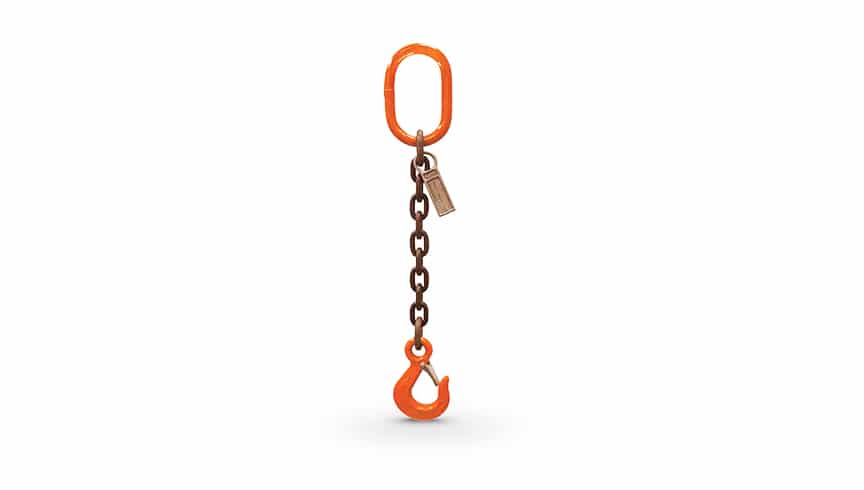
Single-leg slings may have either a hook or collector ring as the upper end fitting. Here are some examples of the types of configurations:
#1 SJG Chain Sling
S – Single-leg
J – Upper end fitting is a j-hook
G – Lower end fitting is a grab hook
#2 SOG Chain Sling
S – Single-leg
O – Upper end fitting is an oblong master link
G – Lower end fitting is a grab hook
#3 SSG Chain Sling
S – Single-leg
S – Upper end fitting is a sling hook (hook with a metal clasp latch)
G – Lower end fitting is a grab hook (grab back into a link of chain)
Double-Leg Chain Slings
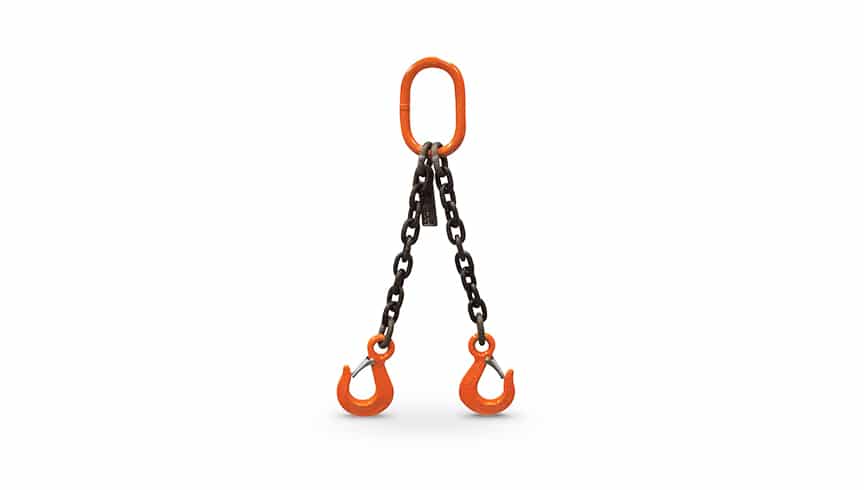
Double-leg chain slings, like all multiple-leg chain slings, will have a collector ring at the top. Here are examples of double-leg chain sling configurations:
#1 DOS Chain Sling
D – Double-leg
O – Collector ring is an oblong master link
S – Lower end fittings are sling hooks
#2 DOG Chain Sling
D – Double-leg
O – Collector ring is an oblong master link
G – Lower end fittings are grab hooks
Triple-Leg and Quad-Leg Chain Slings
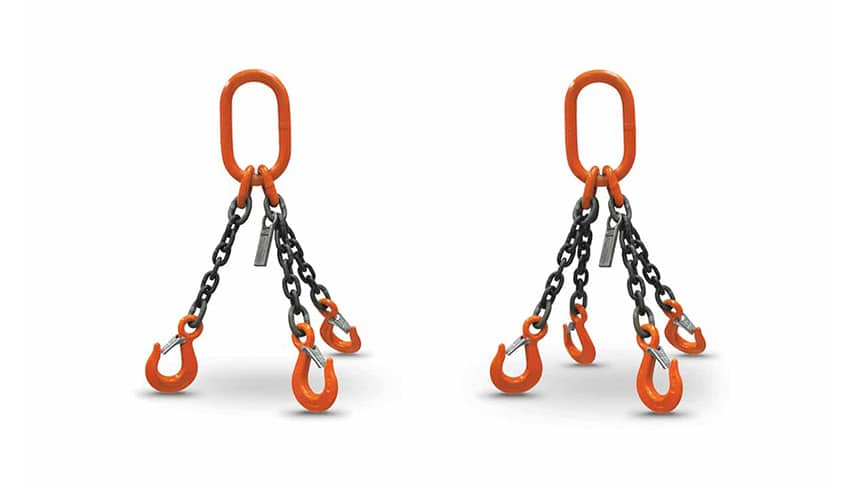
Triple-leg and quad-leg chain slings, like all multiple-leg chain slings, will have a collector ring at the top. Here are several examples:
#1 TOS Chain Sling
T – Triple-leg
O – Collector ring is an oblong master link
S – Lower end fittings are sling hooks
#2 QOS Chain Sling
Q – Quadruple-leg
O – Collector ring is an oblong master link
S – Lower end fittings are sling hooks
Chain Sling Assemblies with Adjusters
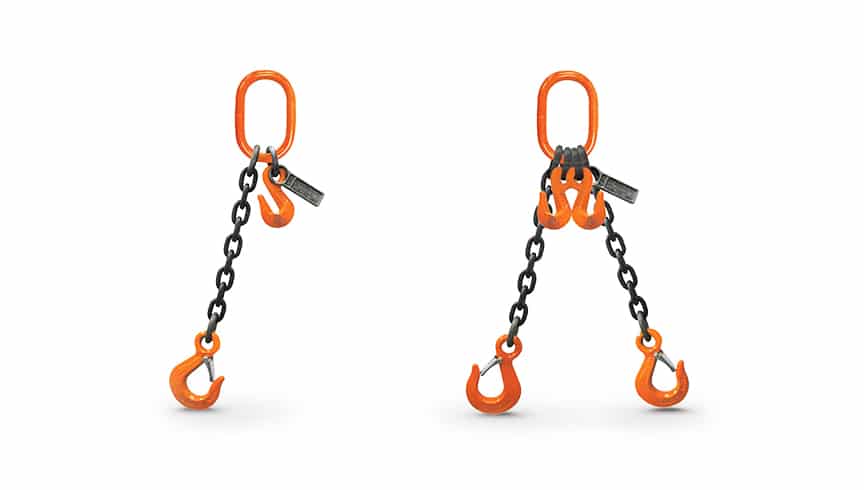
Shorteners — usually grab hooks — may or may not be present on the chain sling assembly. Here are some examples:
#1 DOSA
D – Double-leg
O – Collector ring is an oblong master link
S – Lower end fittings are sling hooks
A – Shorteners are present less than 2” from the collector ring
#2 DOSB
D – Double-leg
O – Collector ring is an oblong master link
S – Lower end fittings are sling hooks
B – Shorteners are present on a length of chain more than 2” from the collector ring
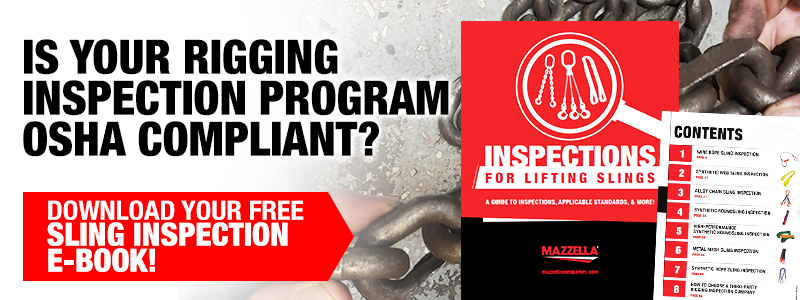
What Grades of Chain Are Recommended for Lifting and Rigging Applications?
The main factors that will help determine what is the best alloy steel chain sling for your lifting needs are:
- Size
- Grade
- Number of legs
- Length
- Hardware used within the sling
Grades of Chain
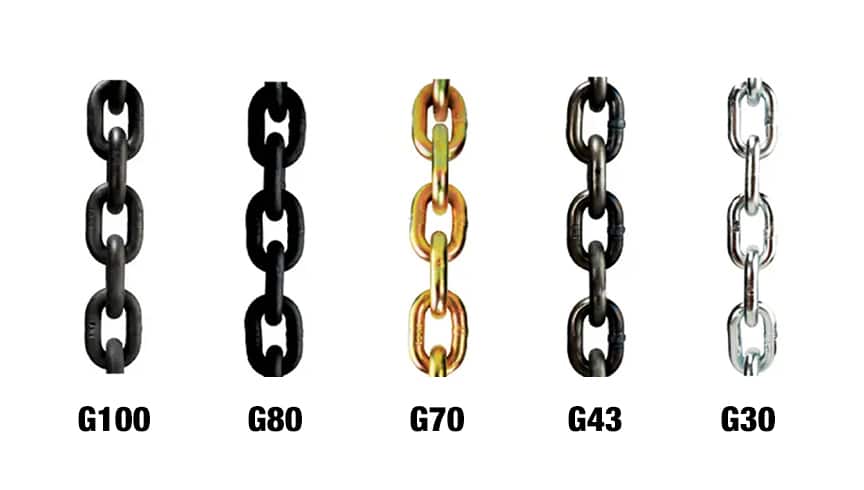
There are only three grades of chain that, per industry standards, are acceptable for executing overhead lifts:
- Grade 80
- Grade 100
- Grade 120
Anything less than Grade 80 chain is made for transport, or general-use, but not overhead lifting. Grade 70 chain is a transportation chain used to tie-down loads on the back of flatbed trailers. However, it is never recommended for overhead lifting.
Grade 120 chain is made by very few manufacturers in the United States. While it is available, it isn’t always readily accessible. Grade 80 and Grade 100 are generally 99% of what comes out of Mazzella’s rigging shops across the country.
***One exception to this rule is Grade 63 chain. This stainless steel grade of chain is required in food grade AND some specific chemical applications.
Sling Length
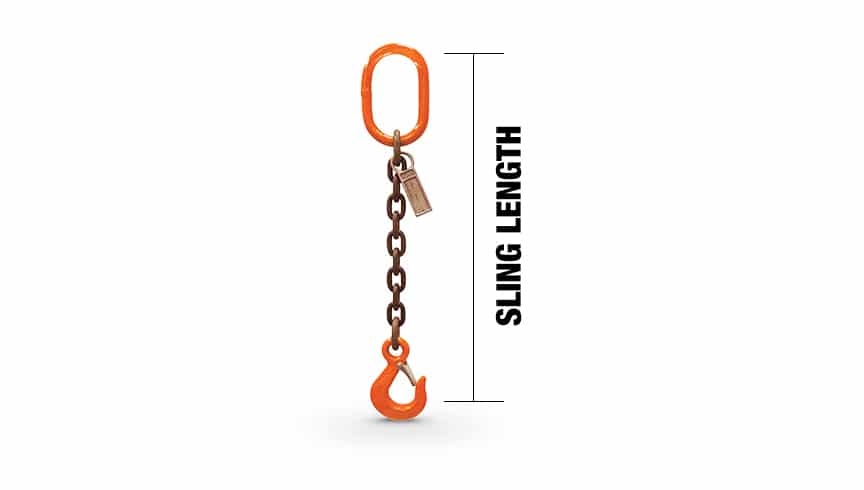
When Mazzella measures chain, we measure from the top bearing point on one end of the chain. If you have a single leg of chain with a hook on each end, it will be measured from the bearing points of each one of those hooks.
For multi-leg alloy steel chain slings, you will have an oblong master link (collector ring) that each of the legs attach to. Multi-leg slings will be measured from the bearing point of the master link down to the bearing point of the hook.
Hardware Fittings
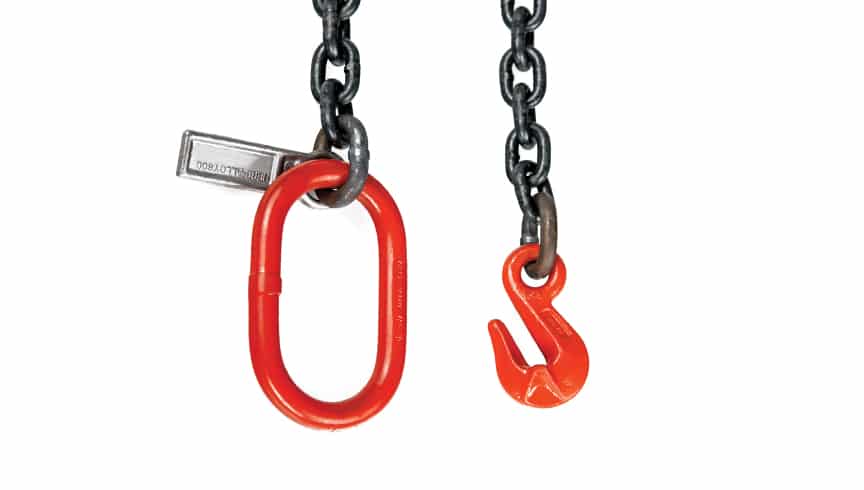
Synthetic and wire rope slings have eyes on both ends, but alloy steel chain slings are different. Rather than having eyes, alloy steel chain slings have end fittings.
For example, with a single-leg alloy steel chain sling, you will have a master link on one end that is able to go over your crane hook. On the other end of that sling, you will have what is known as a grab hook. It actually grabs back into the link of a chain. Essentially, you can create your own eye.
Our lifting experts have seen customers who handle the installation of utility poles. They wrap the chain sling around the pole, tighten it to a certain point, and then, grab it into a link of chain to create their own eye.
What Should You Know Before Purchasing Alloy Steel Chain Slings?
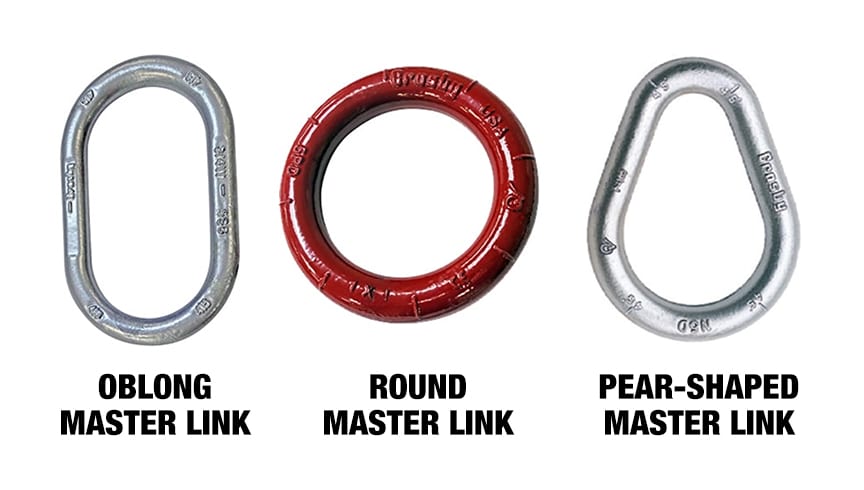
The definition of a rigger is someone that chooses the proper piece of equipment to support and / or manipulate the load. In choosing or replacing an alloy chain sling, there are several factors that determine your choice. Durability and adjustability are two of the major factors, and maybe, the most important components to using an alloy steel chain sling.
You have to know the weight of the load, and a Lifting Specialist is there to help determine if an alloy steel chain sling is going to be able to pick up that weight.
As an end-user, you need to know how many legs your slings must have to distribute the weight of the load and lift your loads safely and securely. It can be one single leg of chain that you can use from a crane hook down to your load. Also, you could use a multi-leg alloy steel chain sling.
In addition to knowing the weight of the load to be lifted and how many legs you need on your slings, you will need to know what your lifting points are. Because the sling needs to attach to those lifting points, depending on how you do that will depend on the type of sling hook being used at the bottom of your chain.
Whether you’re using a multi-leg sling or a single-leg assembly, you need a master link at one end to be able to go over a crane hook. You want to make sure you have a properly-sized master link to account for the size of the crane hook.
Example: If you’re lifting a load that weighs 3,000 lbs., you might be lifting it with a crane hook that’s good for 15 tons. That crane hook would require a larger master link to ensure the sling assembly is properly seated in the bowl of the hook.
What Types of Hardware Could Be Used on an Alloy Steel Chain Sling?
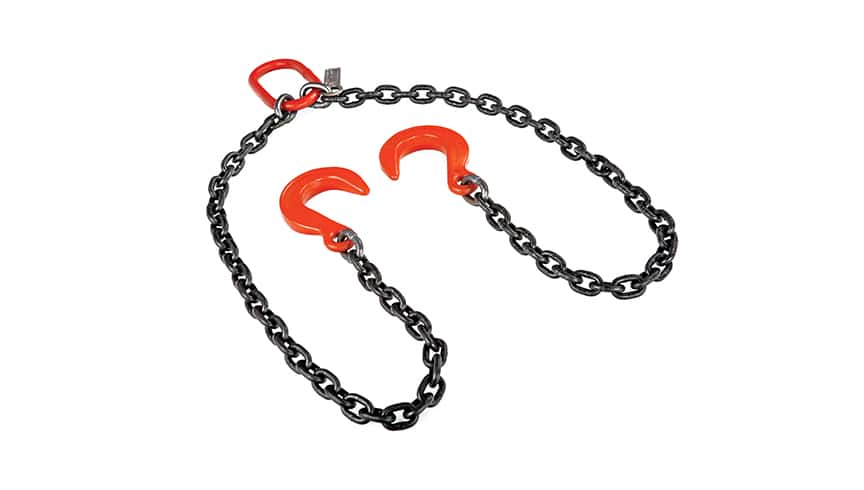
Our specialists have found that most of the time, alloy steel chain slings have a standard hook with a metal clasp latch on one end that you can attach to points on a load. Additionally, you could utilize a grab hook.
If you don’t have a standard or grab hook, other attachments at the bottom of your alloy steel chain slings could be:
- J-hooks
- Foundry hooks
Foundry hooks have a swooping throat to be able to grab through pick points. However, they don’t have a latch. You will want to check local standards before using foundry hooks. In many locations, including the state of Maryland, you cannot use foundry hooks because they don’t have a latch. In Ohio, companies are free to use foundry hooks.
J-hooks, which are smaller than foundry hooks, also do not have latches on them. However, you can have a master link, as well as a D ring, on each end of your chain slings.
How Do You Adjust an Alloy Steel Chain Sling?
When looking at your alloy steel chain slings, you can shorten up legs by using grab hooks.
With a master link at the top of the sling, you can have grab hooks attached. For example, if you have a double-leg chain sling, you put a grab hook on each side of the master link. You can insert the grab hook into links of the chain to shorten up the legs of your sling. The stress on the master link now goes from the grab hook.
Is It Better to Use Mechanical or Welded Chain Slings?
“Mechanical” refers to where you are making the connection from the chain to whatever piece of hardware you’re using. For example, hammer locks actually come apart, and then, will fit through your chain and over your hardware to connect that chain to that hardware. Also, clevis pins can be used, as they directly link the hardware into a piece of chain.
There are places that prefer using welded connections, including industrial and manufacturing settings. Using a mechanical chain sling presents certain dangers, but they are less expensive because it takes less time to manufacture them. Welding that connector point from the hardware to the chain takes time and adds labor costs. Welded chain slings require a cool-down period, and then, a heat-treat process before another cool-down period.
Are Alloy Steel Chain Slings the Right Solution For You?
If you want to lift with strong, durable material, alloy steel chain slings may be the best option for your company. However, here is what you’ll need to know to order the correct sling for your lifting application:
- Working Load Limit
- Number of legs (single or multi-leg assemblies)
- Sling configuration
- Sling length
- Ways to protect slings and loads
If alloy steel chain slings are not a good fit for you, Mazzella offers resources in The Learning Center to help you learn about different types of slings, including:
At Mazzella, we provide ideal lifting solutions — offering all styles of lifting slings, rigging hardware, wire rope, overhead cranes and hoists, and engineered lifting devices. We have more than 30 locations across the United States — fully stocked with different sizes and configurations of rigging products for your next project.
Download our Lifting Slings Types & Terms E-Book to learn more about alloy chain slings. Furthermore, click here to contact a lifting specialist to learn more about or purchase new slings.
Copyright 2022. Mazzella Companies.

